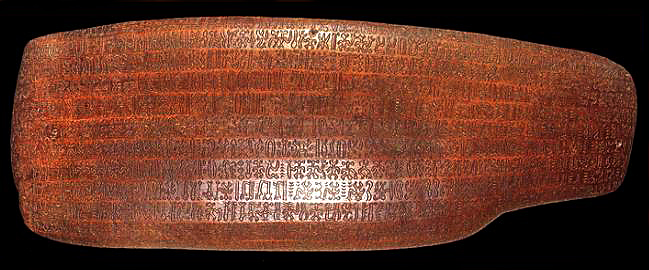Boustrophedon is a style of writing in which alternate lines of writing are reversed, with letters also written in reverse, mirror-style.

The original term comes from Ancient Greek: “like the ox turns [while plowing]”. It is mostly seen in ancient manuscripts and other inscriptions. It was a common way of writing on stone in Ancient Greece.
A fun variation is the reverse boustrophedon: the text in alternate lines is rotated 180 degrees rather than mirrored.
The reader begins at the bottom left-hand corner of a tablet, reads a line from left to right, then rotates the tablet 180 degrees to continue on the next line from left to right again. When reading one line, the lines above and below it appear upside down.

I heard about it on a podcast about the Rapa Nui people of Easter Island. They use used the reverse boustrophedon style for their system of glyphs called Rongorongo, which remains undeciphered.



It’s a common misconception that the ancient man was dumb. In no way was ancient man dumb. However, this concept is dumb as hell. Stick to burying statues, Easter Island people.
Did I miss the joke? This saves eye movement effort. Each line reading an opposite direction makes reading more efficient.
And didn’t the statutes start less buried and the bottoms get further buried by the soft soil flowing due to the trees being cut on the island causing the erosion? Or did I dream I read that somewhere?
The theory that cutting down trees caused ecological collapse is a myth spread by colonizers. The people of Rapa Nui were thriving and the large trees had likely been gone for centuries due to rat infestations brought by the islanders. You’d think this would collapse their ecology but the Rapa Nui people were ingenuitive. Upon noticing the increased erosion and saltiness in their soil from the sea spray they began planting walled gardens and using a technique called rock mulching that actually improved the soil quality. We actually find that the ruins they left behind are still doing their job to improve the soil with even 3 times as many minerals inside the ruins as opposed to outside them.
When the first europeans stumpled upon this island they originally thought it was a desert from a distance but upon arriving found it to be a bustling land of plenty. There was plenty of food and activity. The skeletons we have found actually showed a more nutritious diet than europeans at the time. I should also address the myth of civil war. There is no evidence of this. There are many obsidian knives but they are often found near gardens. There are no fortresses or watch towers or walls like on Rapa Iti which did experience a period of severe warfare. Its likely these people never saw battle. They even had dangerous competitive traditions that may have pacified the more warlike men’s desire for glory.
Its actually suggested by the evidence that their population never did collapse before european arrival. After the dutch arrived in the 1700s disease spread quickly and devastated their population. When the spanish arrive some 48 years later and spread a new batch of disease their population had only just barely recovered. 4 years later there were only a few hundred left and all their statues had been toppled by them. I think their faith in the protection of their ancestors was shattered at this point. They began to great foreigners with weapons
I think you missed the joke.
(Also, regarding trees on Easter island, it’s a popular theory, but if I remember correctly it has been a bit debunked in recent years)
Yes.
They actually never buried their statues. The ones you see in the dirt were the ones that broke during transportation and never made it to the coast to be placed on a pedestal.
Oh, wow. You should post that in TIL.
Less time moving from line to line, and due to the alternating you would have a much harder time accidentally skipping lines.